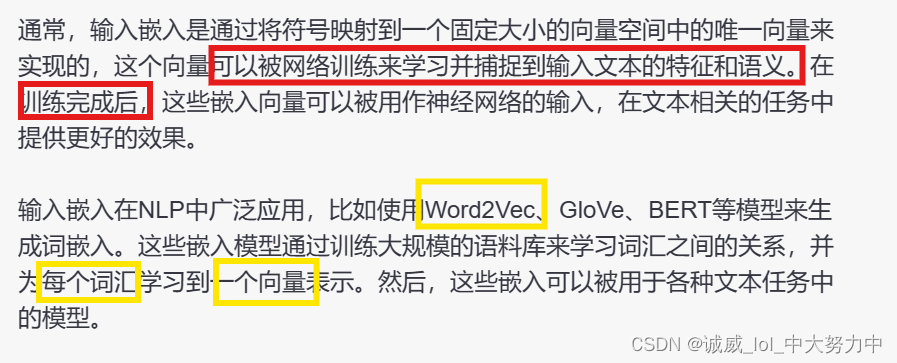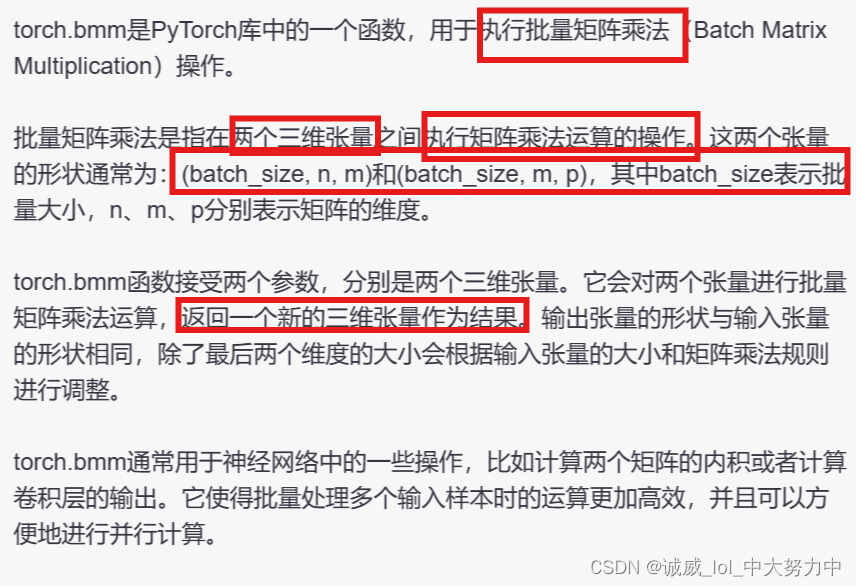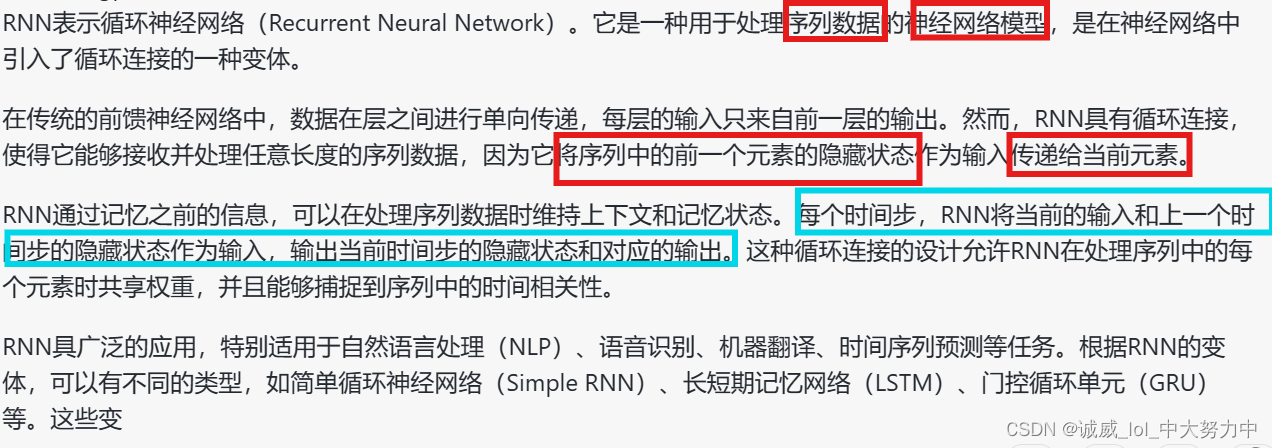一、ppt研读:
1.关于这个 input Embedding 的内容:


2.关于Positional Encoding:


二、慢慢积累,一点点阅读代码:
虽然这次的模块挺多的,但是,这样也就意味着,把这个内化为自己的,就可以获得更大的进步了
1.关于使用git命令获取到源代码:

2.Fix Random Seed部分都是相同的,就是为了结果可以复现:
seed = 73
random.seed(seed)
torch.manual_seed(seed)
if torch.cuda.is_available():
torch.cuda.manual_seed(seed)
torch.cuda.manual_seed_all(seed)
np.random.seed(seed)
torch.backends.cudnn.benchmark = False
torch.backends.cudnn.deterministic = True3.定义一个字符类型转换函数:
def strQ2B(ustring):
"""Full width -> half width"""
# reference:https://ithelp.ithome.com.tw/articles/10233122
ss = []
for s in ustring:
rstring = ""
for uchar in s:
inside_code = ord(uchar)
if inside_code == 12288: # Full width space: direct conversion
inside_code = 32
elif (inside_code >= 65281 and inside_code <= 65374): # Full width chars (except space) conversion
inside_code -= 65248
rstring += chr(inside_code)
ss.append(rstring)
return ''.join(ss)
4.字符处理函数:
def clean_s(s, lang):
if lang == 'en':
s = re.sub(r"\([^()]*\)", "", s) # remove ([text])
s = s.replace('-', '') # remove '-'
s = re.sub('([.,;!?()\"])', r' \1 ', s) # keep punctuation
elif lang == 'zh':
s = strQ2B(s) # Q2B
s = re.sub(r"\([^()]*\)", "", s) # remove ([text])
s = s.replace(' ', '')
s = s.replace('—', '')
s = s.replace('“', '"')
s = s.replace('”', '"')
s = s.replace('_', '')
s = re.sub('([。,;!?()\"~「」])', r' \1 ', s) # keep punctuation
s = ' '.join(s.strip().split())
return s
5.python中的string.split()分割函数:

6.定义整个文字串的处理函数:
```python
def clean_corpus(prefix, l1, l2, ratio=9, max_len=1000, min_len=1):
# 检查已经存在的清洗后文件,如果存在则跳过清洗步骤
if Path(f'{prefix}.clean.{l1}').exists() and Path(f'{prefix}.clean.{l2}').exists():
print(f'{prefix}.clean.{l1} & {l2} exists. skipping clean.')
return
# 打开原始语料文件和清洗后的输出文件
with open(f'{prefix}.{l1}', 'r') as l1_in_f:
with open(f'{prefix}.{l2}', 'r') as l2_in_f:
with open(f'{prefix}.clean.{l1}', 'w') as l1_out_f:
with open(f'{prefix}.clean.{l2}', 'w') as l2_out_f:
# 逐行读取原始语料文件
for s1 in l1_in_f:
s1 = s1.strip() # 去除首尾空格
s2 = l2_in_f.readline().strip()
s1 = clean_s(s1, l1) # 清洗句子 s1
s2 = clean_s(s2, l2) # 清洗句子 s2
s1_len = len_s(s1, l1) # 计算句子 s1 的长度
s2_len = len_s(s2, l2) # 计算句子 s2 的长度
if min_len > 0: # 判断句子长度是否满足最小长度要求,如果不满足则跳过
if s1_len < min_len or s2_len < min_len:
continue
if max_len > 0: # 判断句子长度是否超过最大长度,如果超过则跳过
if s1_len > max_len or s2_len > max_len:
continue
if ratio > 0: # 判断句子长度比例是否满足要求,如果不满足则跳过
if s1_len/s2_len > ratio or s2_len/s1_len > ratio:
continue
# 将清洗后的句子写入输出文件
print(s1, file=l1_out_f)
print(s2, file=l2_out_f)
```
以上是一个用于清洗语料的函数,函数将两个语料文件 `prefix.l1` 和 `prefix.l2` 清洗后保存到 `prefix.clean.l1` 和 `prefix.clean.l2` 文件中。
注释已经逐行添加在代码中。总的来说呢,就是将 太长 或者 太短的 句子进行处理,并且进行一些符号的处理,使得最终得到的句子是比较合理的那种
7.转换为subword units进行处理:
import sentencepiece as spm
vocab_size = 8000
if (prefix/f'spm{vocab_size}.model').exists():
print(f'{prefix}/spm{vocab_size}.model exists. skipping spm_train.') #如果这段文字已经被subword过了,pass
else:
spm.SentencePieceTrainer.train( #否则,就要设置这个SentencePieceTrainer模块的参数的具体数值了
input=','.join([f'{prefix}/train.clean.{src_lang}',
f'{prefix}/valid.clean.{src_lang}',
f'{prefix}/train.clean.{tgt_lang}',
f'{prefix}/valid.clean.{tgt_lang}']),
model_prefix=prefix/f'spm{vocab_size}',
vocab_size=vocab_size,
character_coverage=1,
model_type='unigram', # 'bpe' works as well
input_sentence_size=1e6,
shuffle_input_sentence=True,
normalization_rule_name='nmt_nfkc_cf',
)spm_model = spm.SentencePieceProcessor(model_file=str(prefix/f'spm{vocab_size}.model')) #初始化上述模块
in_tag = {
'train': 'train.clean',
'valid': 'valid.clean',
'test': 'test.raw.clean',
}
#反正下面这里就是利用subword进行文字串的处理
for split in ['train', 'valid', 'test']:
for lang in [src_lang, tgt_lang]:
out_path = prefix/f'{split}.{lang}'
if out_path.exists():
print(f"{out_path} exists. skipping spm_encode.")
else:
with open(prefix/f'{split}.{lang}', 'w') as out_f:
with open(prefix/f'{in_tag[split]}.{lang}', 'r') as in_f:
for line in in_f:
line = line.strip()
tok = spm_model.encode(line, out_type=str)
print(' '.join(tok), file=out_f)8.将上述的字符串利用fairseq处理:
binpath = Path('./DATA/data-bin', dataset_name)
if binpath.exists():
print(binpath, "exists, will not overwrite!")
else:
!python -m fairseq_cli.preprocess \
--source-lang {src_lang}\
--target-lang {tgt_lang}\
--trainpref {prefix/'train'}\
--validpref {prefix/'valid'}\
--testpref {prefix/'test'}\
--destdir {binpath}\
--joined-dictionary\
--workers 2
9.原来真的需要些log实验日志:
logging.basicConfig(
format="%(asctime)s | %(levelname)s | %(name)s | %(message)s",
datefmt="%Y-%m-%d %H:%M:%S",
level="INFO", # "DEBUG" "WARNING" "ERROR"
stream=sys.stdout,
)
proj = "hw5.seq2seq"
logger = logging.getLogger(proj)
if config.use_wandb:
import wandb
wandb.init(project=proj, name=Path(config.savedir).stem, config=config)
10.关于fairseq(facebook AI Research Sequence to Sequence Toolkit)这个库的初探
(1)概念:它基于PyTorch开发,提供了多种自然语言处理任务的模型,包括神经机器翻译、语音识别、文本生成等
(2)功能分块
(3)使用方式:(我感觉就是一种别具一格形式的函数调用)


也可以参考这一篇文章
11.torch.bmm(tensor1,tensor2)这种批量的矩阵乘法运算:

12.了解一下,什么叫做RNN(Recurrent Neural Network):

二、下面重点研读 encoder 、 attention 和 decoder部分的代码(目前来说其他部分有些吃力,等我够强大了,再回来报仇!!!虽迟未晚)
1.Encoder部分的代码:
class RNNEncoder(FairseqEncoder): #通过继承来自FairseqEncoder的这个类模型
def __init__(self, args, dictionary, embed_tokens): #_init_初始化函数:参数:arg参数数组中包含着embed_dim、hidden_dim、num_layers等参数,dictionary字符集,embed_tokens这个算是字符还是embedding之后的向量呢?
super().__init__(dictionary) #用字符初始化父类的_init_函数
self.embed_tokens = embed_tokens #把embed_tokens参数传进去
self.embed_dim = args.encoder_embed_dim #原来arg中就有dim等参数
self.hidden_dim = args.encoder_ffn_embed_dim #中间层的dim
self.num_layers = args.encoder_layers #layer的层数
self.dropout_in_module = nn.Dropout(args.dropout) #args中的dropout概率参数也要传递进去
self.rnn = nn.GRU( #定义这个模型的rnn结构,
self.embed_dim, #传参:embed_dim就是embed时的dim维度
self.hidden_dim, #hidden_dim就是中间层的dim维度
self.num_layers, #num_layers层数
dropout=args.dropout, #dropout概率参数
batch_first=False,
bidirectional=True
)
self.dropout_out_module = nn.Dropout(args.dropout)
self.padding_idx = dictionary.pad() #pad()又是这个用来对不够长的文段进行pad,然后返回索引
def combine_bidir(self, outs, bsz: int):
out = outs.view(self.num_layers, 2, bsz, -1).transpose(1, 2).contiguous()
return out.view(self.num_layers, bsz, -1) #就是对outs结构的重新排布
def forward(self, src_tokens, **unused): #定义encoder的运行函数了
bsz, seqlen = src_tokens.size() #获取tokens的数量
# get embeddings
x = self.embed_tokens(src_tokens) #对tokens字符进行embedding得到向量序列
x = self.dropout_in_module(x) #经过一次dropout,防止overfit
# B x T x C -> T x B x C
x = x.transpose(0, 1)
# pass thru bidirectional RNN
h0 = x.new_zeros(2 * self.num_layers, bsz, self.hidden_dim) #创建一个多维向量
x, final_hiddens = self.rnn(x, h0) #将x数据 和 h0传进到rnn模型中,得到输出x和final_hiddens
outputs = self.dropout_out_module(x) #再将x通过一个dropout得到outputs
# outputs = [sequence len, batch size, hid dim * directions]
# hidden = [num_layers * directions, batch size , hid dim]
# Since Encoder is bidirectional, we need to concatenate the hidden states of two directions
final_hiddens = self.combine_bidir(final_hiddens, bsz)
# hidden = [num_layers x batch x num_directions*hidden]
encoder_padding_mask = src_tokens.eq(self.padding_idx).t()
return tuple(
(
outputs, # seq_len x batch x hidden
final_hiddens, # num_layers x batch x num_directions*hidden
encoder_padding_mask, # seq_len x batch
)
)
def reorder_encoder_out(self, encoder_out, new_order): #用于beam_search,反正不重要
# This is used by fairseq's beam search. How and why is not particularly important here.
return tuple(
(
encoder_out[0].index_select(1, new_order),
encoder_out[1].index_select(1, new_order),
encoder_out[2].index_select(1, new_order),
)
)2.attention函数的设计:
class AttentionLayer(nn.Module): #用nn.Module设计一个self-attention的网络结构
def __init__(self, input_embed_dim, source_embed_dim, output_embed_dim, bias=False): #定义初始化函数
super().__init__()
self.input_proj = nn.Linear(input_embed_dim, source_embed_dim, bias=bias) #第一个Linear层-input
self.output_proj = nn.Linear(
input_embed_dim + source_embed_dim, output_embed_dim, bias=bias #第二个Linear层-output
)
def forward(self, inputs, encoder_outputs, encoder_padding_mask): #定义运行函数
# inputs: T, B, dim
# encoder_outputs: S x B x dim
# padding mask: S x B
# convert all to batch first
#通过transpose将这些数据都转化为第零维的是batch
inputs = inputs.transpose(1,0) # B, T, dim
encoder_outputs = encoder_outputs.transpose(1,0) # B, S, dim
encoder_padding_mask = encoder_padding_mask.transpose(1,0) # B, S
# project to the dimensionality of encoder_outputs
x = self.input_proj(inputs) #调用input_linear函数
# compute attention
# (B, T, dim) x (B, dim, S) = (B, T, S) #这里说的就是批量的矩阵乘法运算
attn_scores = torch.bmm(x, encoder_outputs.transpose(1,2))
# cancel the attention at positions corresponding to padding
if encoder_padding_mask is not None:
# leveraging broadcast B, S -> (B, 1, S)
encoder_padding_mask = encoder_padding_mask.unsqueeze(1)
attn_scores = (
attn_scores.float()
.masked_fill_(encoder_padding_mask, float("-inf"))
.type_as(attn_scores)
) # FP16 support: cast to float and back
# softmax on the dimension corresponding to source sequence
attn_scores = F.softmax(attn_scores, dim=-1) #将attn_scores通过一个softmax
# shape (B, T, S) x (B, S, dim) = (B, T, dim) weighted sum
x = torch.bmm(attn_scores, encoder_outputs) #再次进行矩阵乘法
# (B, T, dim)
x = torch.cat((x, inputs), dim=-1) #沿着最后一维进行向量的拼接
x = torch.tanh(self.output_proj(x)) # concat + linear + tanh(双曲正切值)
# restore shape (B, T, dim) -> (T, B, dim)
return x.transpose(1,0), attn_scores #返回x,和对应的attn_scores分数3.Decoder的结构设计:
class RNNDecoder(FairseqIncrementalDecoder): #继承来自FairseqIncrementalDecoder,有点d
def __init__(self, args, dictionary, embed_tokens): #初始化参数:和encoder那边一样的基本
super().__init__(dictionary)
self.embed_tokens = embed_tokens
#2个断言,不用管
assert args.decoder_layers == args.encoder_layers, f"""seq2seq rnn requires that encoder
and decoder have same layers of rnn. got: {args.encoder_layers, args.decoder_layers}"""
assert args.decoder_ffn_embed_dim == args.encoder_ffn_embed_dim*2, f"""seq2seq-rnn requires
that decoder hidden to be 2*encoder hidden dim. got: {args.decoder_ffn_embed_dim, args.encoder_ffn_embed_dim*2}"""
#把参数传进去
self.embed_dim = args.decoder_embed_dim
self.hidden_dim = args.decoder_ffn_embed_dim
self.num_layers = args.decoder_layers
self.dropout_in_module = nn.Dropout(args.dropout)
self.rnn = nn.GRU( #取nn.GRU模板作为rnn结构
self.embed_dim,
self.hidden_dim,
self.num_layers,
dropout=args.dropout,
batch_first=False,
bidirectional=False
)
self.attention = AttentionLayer( #把上面定义的那个attentionLayer涌过来
self.embed_dim, self.hidden_dim, self.embed_dim, bias=False
)
# self.attention = None
self.dropout_out_module = nn.Dropout(args.dropout)
if self.hidden_dim != self.embed_dim: #是否需要Linear层的问题
self.project_out_dim = nn.Linear(self.hidden_dim, self.embed_dim)
else:
self.project_out_dim = None
if args.share_decoder_input_output_embed:
self.output_projection = nn.Linear(
self.embed_tokens.weight.shape[1],
self.embed_tokens.weight.shape[0],
bias=False,
)
self.output_projection.weight = self.embed_tokens.weight
else:
self.output_projection = nn.Linear(
self.output_embed_dim, len(dictionary), bias=False
)
nn.init.normal_(
self.output_projection.weight, mean=0, std=self.output_embed_dim ** -0.5
)
def forward(self, prev_output_tokens, encoder_out, incremental_state=None, **unused): #定义整个Decoder的运行过程
# extract the outputs from encoder
encoder_outputs, encoder_hiddens, encoder_padding_mask = encoder_out #从encoder那里取到数据
# outputs: seq_len x batch x num_directions*hidden
# encoder_hiddens: num_layers x batch x num_directions*encoder_hidden
# padding_mask: seq_len x batch
if incremental_state is not None and len(incremental_state) > 0:
# if the information from last timestep is retained, we can continue from there instead of starting from bos
prev_output_tokens = prev_output_tokens[:, -1:]
cache_state = self.get_incremental_state(incremental_state, "cached_state")
prev_hiddens = cache_state["prev_hiddens"]
else:
# incremental state does not exist, either this is training time, or the first timestep of test time
# prepare for seq2seq: pass the encoder_hidden to the decoder hidden states
prev_hiddens = encoder_hiddens
bsz, seqlen = prev_output_tokens.size()
#主要的操作都在下面了哇!
# embed tokens
x = self.embed_tokens(prev_output_tokens) #对tokens进行embedding得到向量序列
x = self.dropout_in_module(x) #通过一次dropout
# B x T x C -> T x B x C
x = x.transpose(0, 1)
# decoder-to-encoder attention
if self.attention is not None:
x, attn = self.attention(x, encoder_outputs, encoder_padding_mask) #有attention就进行attention
# pass thru unidirectional RNN
x, final_hiddens = self.rnn(x, prev_hiddens) #通过rnn结构
# outputs = [sequence len, batch size, hid dim]
# hidden = [num_layers * directions, batch size , hid dim]
x = self.dropout_out_module(x)
# project to embedding size (if hidden differs from embed size, and share_embedding is True,
# we need to do an extra projection)
if self.project_out_dim != None:
x = self.project_out_dim(x)
# project to vocab size
x = self.output_projection(x)
# T x B x C -> B x T x C
x = x.transpose(1, 0)
# if incremental, record the hidden states of current timestep, which will be restored in the next timestep
cache_state = {
"prev_hiddens": final_hiddens,
}
self.set_incremental_state(incremental_state, "cached_state", cache_state)
return x, None
def reorder_incremental_state( #下面就是用来进行beam_search的内容,暂时不管了
self,
incremental_state,
new_order,
):
# This is used by fairseq's beam search. How and why is not particularly important here.
cache_state = self.get_incremental_state(incremental_state, "cached_state")
prev_hiddens = cache_state["prev_hiddens"]
prev_hiddens = [p.index_select(0, new_order) for p in prev_hiddens]
cache_state = {
"prev_hiddens": torch.stack(prev_hiddens),
}
self.set_incremental_state(incremental_state, "cached_state", cache_state)
return目前实力还不足以让我完成hw5,君子报仇,十年不晚